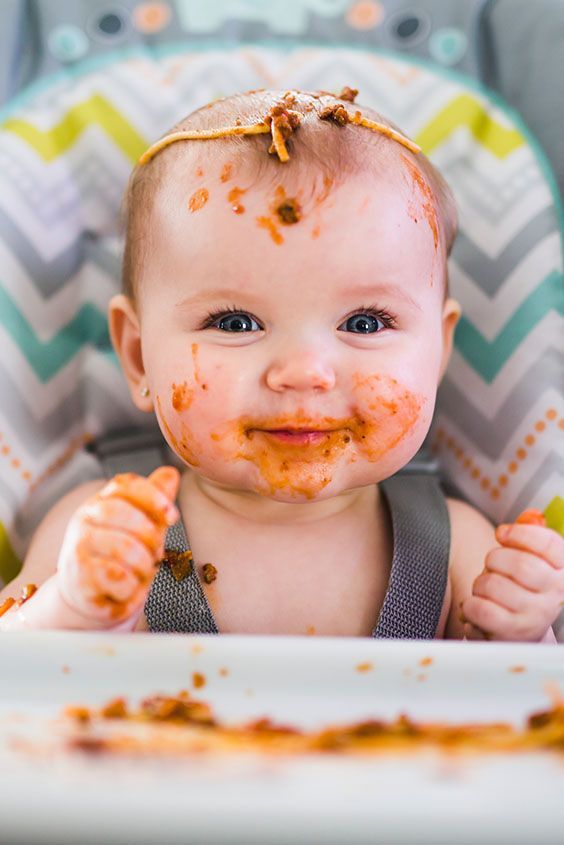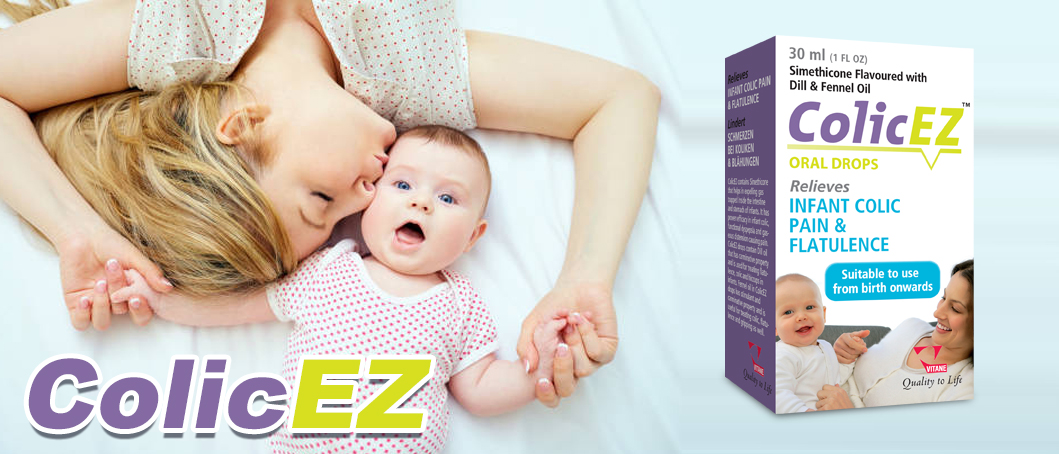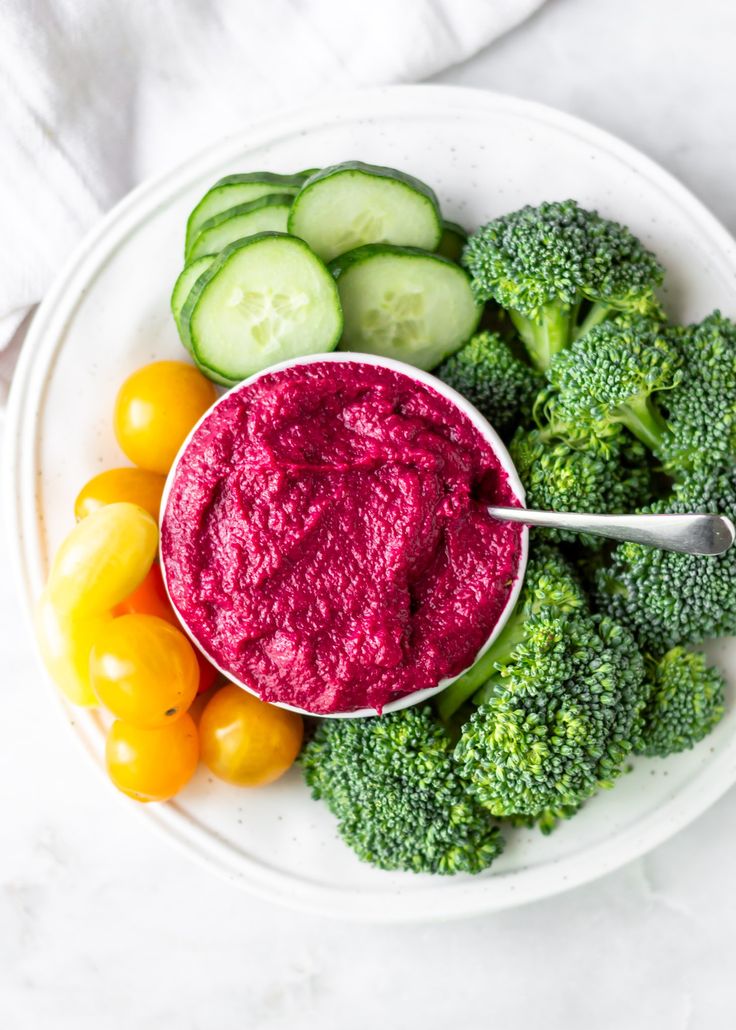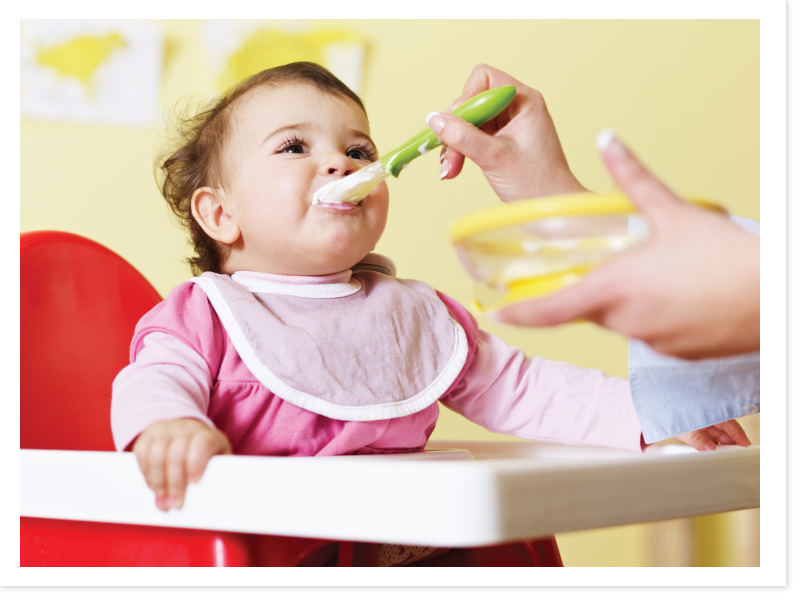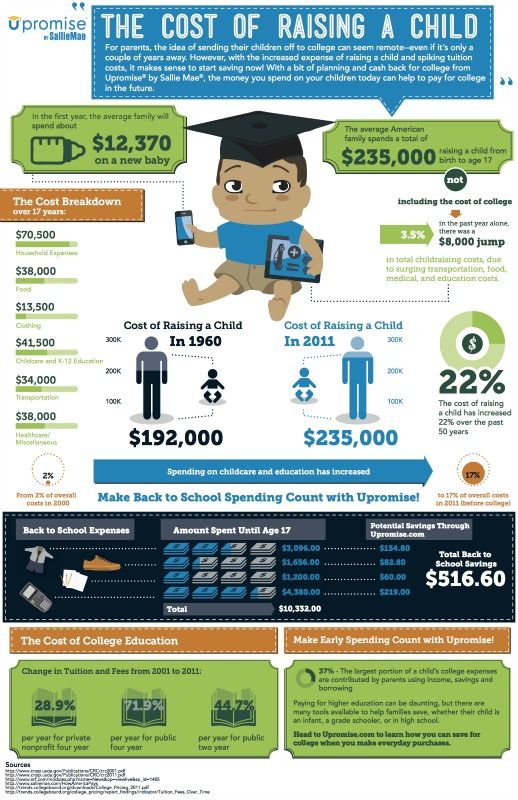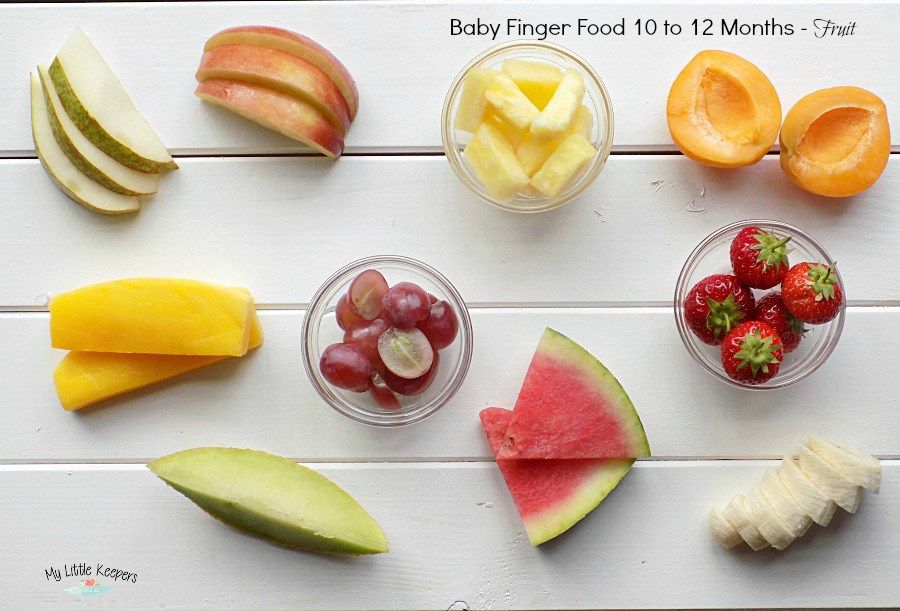When to spoon feed your baby
How to Spoon Feed Baby the Right Way!
Learn how to spoon feed baby even if you’re using baby led weaning, and how to troubleshoot baby gagging, throwing food on the floor, and more!
Affiliate links used below. See our full disclosure.
Starting solid foods is an exciting time for you and your baby! But, it’s easy to feel overwhelmed with exactly how to spoon feed your baby.
Is there a right way?
A wrong way?
Or, maybe your baby is having a hard time eating from a spoon?
As a pediatric OT, I’ll be answering all those questions so you can feel confident getting started or troubleshooting spoon feeding your baby.
When Should You Introduce Purees?
Let’s get started with the best time to start spoon feeding your baby.
In the past, it was recommended to introduce solids between 4-6 months. Some doctors would even recommend introducing thin cereals before that or adding them into the bottle.
Your parents may have fed you this way.
But, the American Academy of Pediatrics now recommends waiting until 6 months of age before introducing solids to your baby. They continue to recommend soft or pureed foods as the first introduction to solid foods in order to prevent choking.
We now know that babies’ digestion systems just aren’t mature enough to handle foods and that most don’t have the postural control for safe swallowing before 6 months.
Before 6 months, a powerful tongue thrust is also likely to be present which means your baby may inadvertently push the food back out of their mouth when you try to spoon feed them at an earlier age.
Parents often confuse this with a baby not liking the baby food, but it’s actually an involuntary action.
So, despite what well meaning grandparents may say, we now know waiting till 6 months is the best time frame for beginning to spoon feed your baby.
Head to our Feeding Schedule for 6-7 month olds to get an idea of how, and often when, you should be spoon feeding your baby.![]()
What About Baby Led Weaning (BLW)?
In more recent years, there has been a huge movement towards Baby Led Weaning (BLW).
Baby led weaning is a method for introducing solid foods by allowing your baby to feed themselves rather than be spoon fed by a parent. Read about the pros and cons of Baby Led Weaning.
Baby Led Weaning gives babies the ultimate sensory experience while they eat, but it can also lead to delayed introduction of solids during your baby’s optimal window if they aren’t getting the hang of eating BLW type foods.
Some babies do really well learning to eat with BLW, and some don’t.
Whether you choose to go the BLW route or not, purees are still important to feed your baby sometimes because you’ll want them to also be able to eat foods like applesauce, yogurts, and soups.
Check out our Mega List of Table Foods for great food ideas to start with.
How to Start Spoon Feeding Baby
Step #1: Make sure that they’re 6 months old, have good head control, and can sit upright to eat and swallow.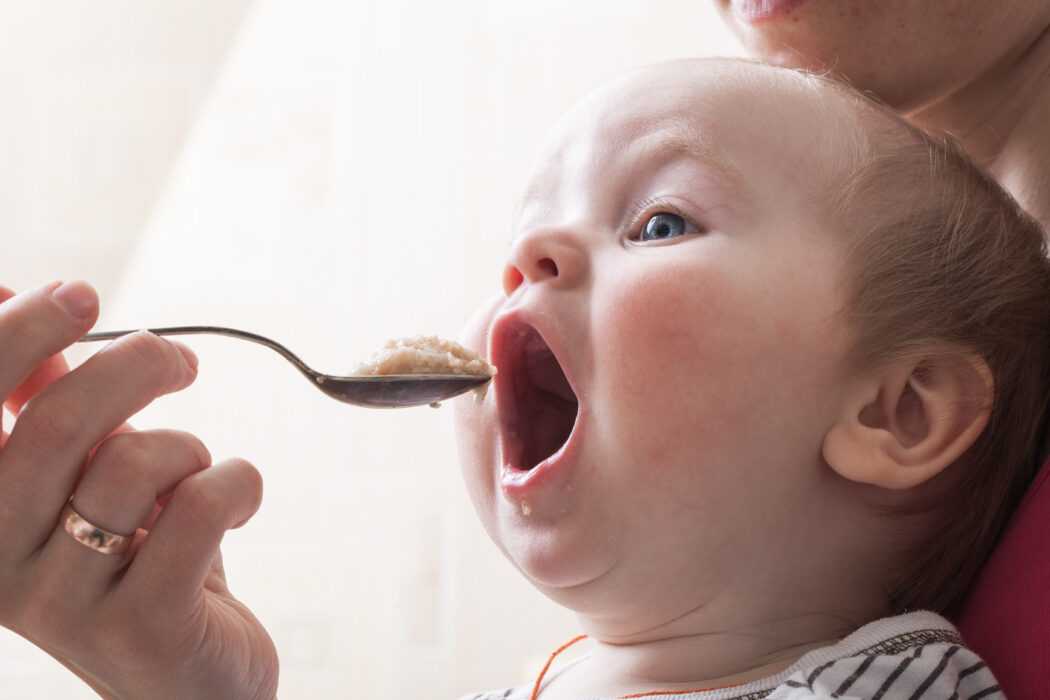
Step #2: Get them in the right position.
The position of your baby is often overlooked. It’s easy to sit them on your lap while feeding them or feed them while they’re in the car seat. But that isn’t the safest position and can impair the development of their feeding skills.
Sitting on your lap or not in a supported seat is actually more challenging for babies. If your baby is focusing all their energy on sitting upright, they aren’t able to use their mouth as effectively.
To ensure your baby is seated properly, position them in an age appropriate booster seat or highchair with a footrest.
Ideally their hips, knees and feet should be at a 90 degree angle if possible.
This means that when babies are first learning to eat, they should have support under their feet and they shouldn’t look slumped over. Not every highchair or booster seat does a good job keeping your little one in the right position.
My absolute favorite chair that grows with them into childhood is the Tripp Trapp, it’s an investment, but they’re so well made, they last forever.
My son is 7 and has been using it since he was 6 months old!
The Keekaroo is another option that’s a little lower in price.
Step #3: Use a spoon with a flat small bowl, it’s easier for your baby to remove the food.
The bowl of the spoon is so important. You want it to be mostly flat or to have a shallow bowl. That means it can’t hold too much of the puree on it.
The spoon should also have a narrow bowl. If your baby is right around 6 months old, their mouth isn’t big. The narrow bowl fits in their mouth much better than a big wide spoon.
See a list of our favorite spoons at the end.
Step #4: Choose a totally smooth thinner baby food.
If you’re using store bought baby food use stage 1 for the first feedings. If you’re making homemade baby food, you don’t want the food to be too thick. Think about making it thick enough for baby to swallow, but not so thin it’s like liquid.
Homemade baby food at this stage should spill off the spoon easily, but still have some stuck to the spoon when you turn it upside down.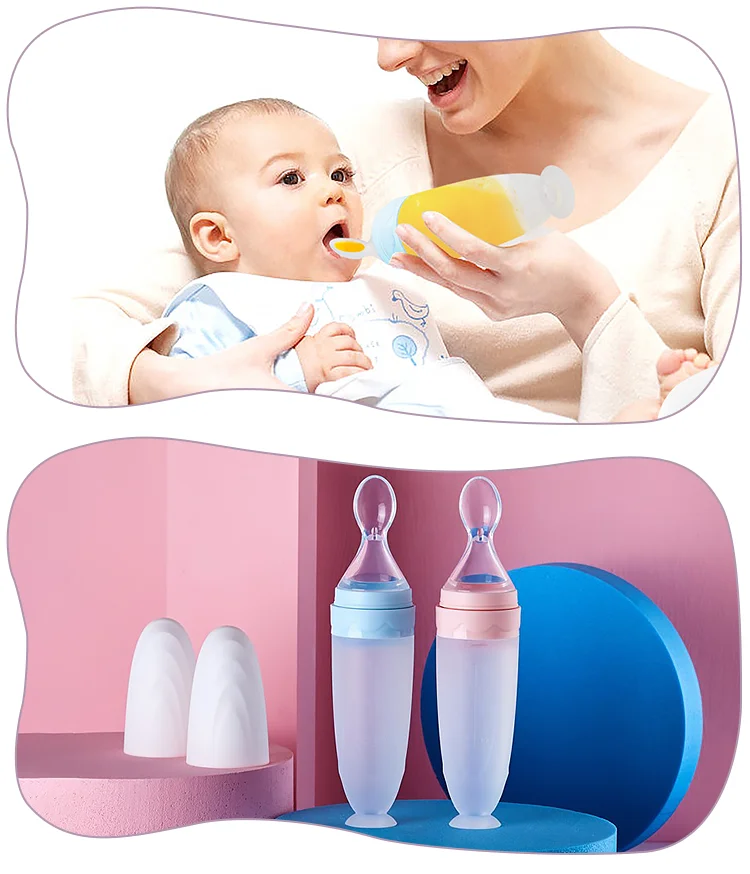
Step #5: Place the right amount of puree on the spoon.
You’ll want to avoid overfilling or under-filling the spoon. You should have some puree on it, ideally near the front of the spoon.
Avoid scooping and loading up the spoon with as much puree as possible. This can be really overwhelming to your baby, especially if they’re just learning to eat purees.
Too much food in their mouth can also trigger their gag reflex.
If your baby does gag, don’t panic, it’s normal. Gagging and choking are two different things. Read more about what to do when babies gag eating.
Step #6: Let your baby decide when to take a bite.
Place the spoon right in front of your baby and wait until they open their mouth. This puts them in charge of their responsibility right from the start, they are the ones that decide to eat.
You want to avoid opening their mouth for them or trying to sneak a bite in their mouth when they look away.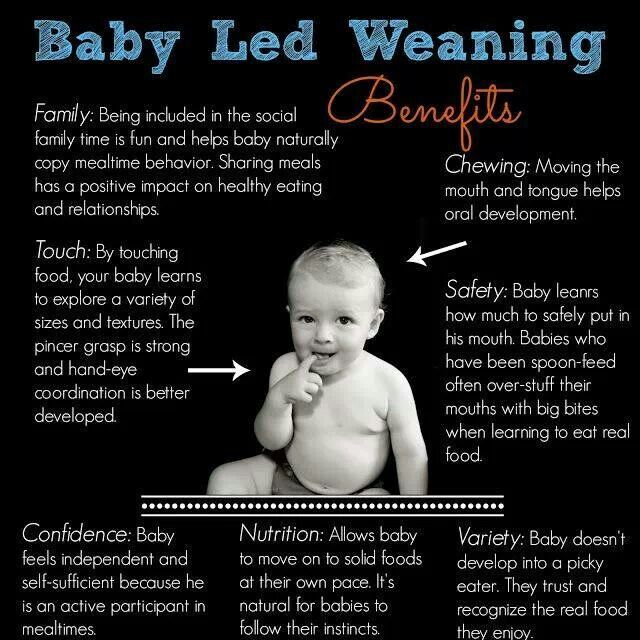
Helping your baby learn that they get to decide when to take a bite can reduce feeding battles and picky eating in the years to come.
Step #7: Place the spoon in the center of their mouth.
The spoon should go in the center of their mouth, above their tongue. You may gently use the back of the spoon to add a small bit of pressure to the middle belly of the tongue.
This is helpful if their tongue seems to be moving quite a bit.
Step 8: Wait for them to close their mouth.
When you’re excited and you really want them to take a bite, it can be hard to wait! But be sure to wait until they close their mouth on the spoon.
This lets them know what their job is, and helps lay the foundation for them to be able to feed themselves.
What to Avoid When Spoon Feeding Baby…
You have 8 simple steps to follow! But, there are a few things you’ll want to avoid. You’ll likely see others doing these things while feeding their babies, because they’re all very common.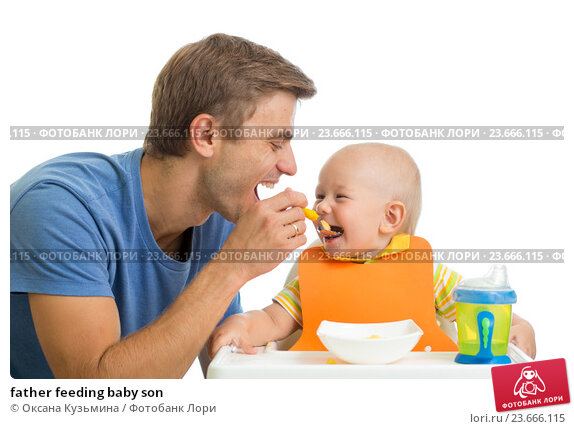
However, each of them can cause difficulties with eating and swallowing either in the moment you’re feeding your baby or in the future. Here’s what to avoid…
- Avoid scraping food on the roof of your baby’s mouth. You want to wait until your little one closes their mouth on the spoon.
- Don’t feed them in a reclined position. Car seats, strollers, and infant positioners all should be avoided. An upright high chair or booster seat is ideal to make sure your baby doesn’t gag, choke, or aspirate.
- Avoid distractions like the TV, phone, or toys. If they’re distracted while eating, they aren’t fully experiencing all the different flavors and textures.
- No force feeding. Let your little one decide when to take a bite. This reduces the chance of picky eating later on and sets them up for positive mealtimes in the future.
In these early days, some babies need a lot of time to get used to purees. However, if your baby is reaching the 8-9 month mark and still struggling, there could be some underlying difficulties that need addressed.
However, if your baby is reaching the 8-9 month mark and still struggling, there could be some underlying difficulties that need addressed.
See our free workshop to learn more and contact your child’s doctor.
- Don’t overfill the spoon. You want a medium amount of puree on the spoon, near the front of the bowl.
Troubleshooting Spoon Feeding Challenges
It’s very normal for babies to need some help getting the hang of eating purees. They’re learning and may need a little more time. Here’s some common challenges you might be faced with and what you can do…
Challenge #1: Your baby won’t open their mouth
When your baby won’t open their mouth for the spoon, this can be really discouraging as a parent of a new eater!
Modeling is especially helpful in these cases. Take your own spoon and a little bite of the puree. Open your mouth wide and really over exaggerate what you’re doing.
Show your baby how to do it.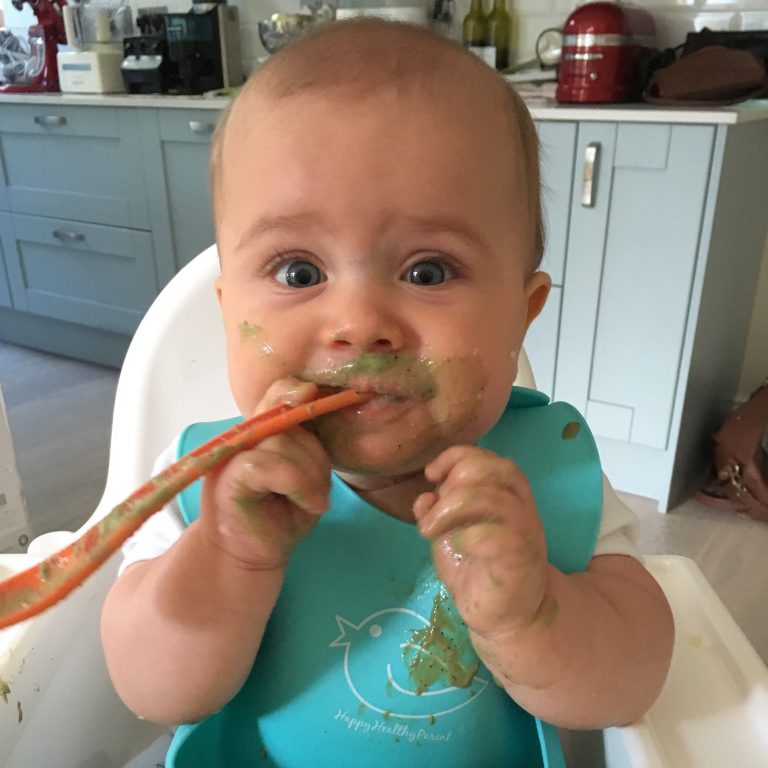
You can also try placing a mirror in front of your baby while they eat or give them their own spoon that is pre-dipped with puree to try out.
Challenge #2: Your baby won’t close their mouth on the spoon
If your baby won’t close their mouth on the spoon, scraping the puree into their mouth is tempting. You want to avoid this!
It doesn’t teach them how to use their muscles to eat. It also teaches them that they have to eat a particular food, which can encourage pickiness later on.
Frequently, if they don’t close their mouth on the spoon, it’s because they don’t know they’re supposed to.
You can encourage this by very gently rolling your finger above their upper lip in a downward motion towards their mouth. Showing them how to take a bite with an exaggerated close is also helpful.
Keep practicing for up to 8 months of age before seeking more help from the doctor or a feeding therapist.
Challenge #3: Your baby gags with purees
Gagging can get a bad wrap. Gagging happens first as a protective mechanism to prevent your baby from choking. But it can also turn into a problem if it starts to happen often. Or, before food even hits their mouth.
Gagging happens first as a protective mechanism to prevent your baby from choking. But it can also turn into a problem if it starts to happen often. Or, before food even hits their mouth.
Sometimes excessive gagging happens because your baby’s mouth is sensitive to sensory input, or the textures of food.
It can be helpful to desensitize their mouth with teethers or toothbrushing. You can brush their gums even if they don’t have teeth yet!
Challenge #4: Your baby throws their bowl or spoon
We hear parents tell us that their baby is throwing their food, plate, or utensils all the time. If your baby is doing this, you’re not alone at all!
Usually this happens just because they’re testing things out at first. It makes a fun noise or you make a funny face whenever they do it.
It can be tempting to react negatively whenever food is thrown. Try to resist the urge and stay as neutral as possible. A negative reaction is still a reaction and can sometimes encourage them to do it more.
Try using a simple phrase like, “our food stays on the tray” and move on. It can also be helpful to use plates and bowls that suction well to their highchair to buy you a bit more time before the food flies.
Learn more in how to help babies and toddlers stop throwing food.
Challenge #5: Your baby always wants to hold the spoon
This is actually such a good thing, even though it can feel frustrating when you’re just introducing purees. They’re motivated to feed themselves!
Give them a spoon of their own that has been dipped in a little bit of puree while also having your own spoon. You can take turns doing the feeding.
It might be frustrating because they will make a big mess at first and likely will get just a little bit of puree in their mouth. This is a great step towards their independence!
While 6 months is the perfect time to start spoon feeding your baby, and you should give your baby plenty of time to get the hang of it, your baby should be eating purees regularly by 8 months of age, even if it’s a small amount.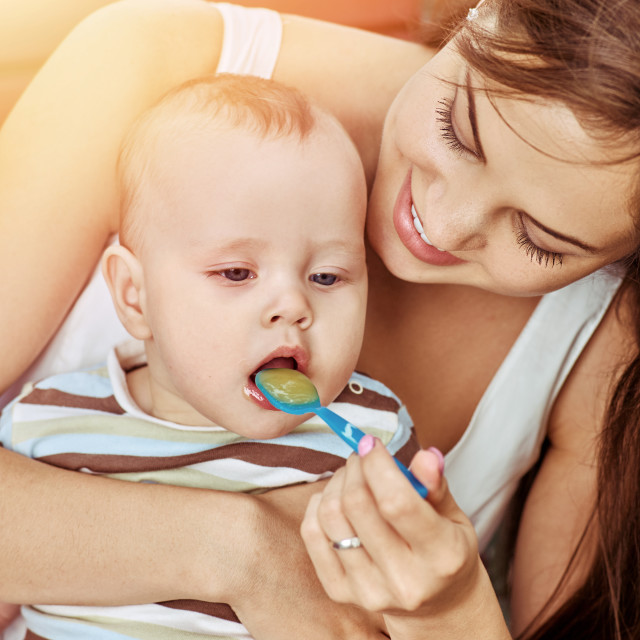
If you’ve tried all the tips and tricks we’ve suggested and they still aren’t eating solids by 9 months, it’s time to get some more help!
Our free Table Foods Workshop is the perfect place to start. It’s full of suggestions that you can start using immediately. Save your seat HERE.
Our Favorite Baby Feeding Spoons
- Take and toss spoons
- These are great spoons. They have a narrow and flatter bowl. They’re also super affordable. You certainly can take and toss them, as they suggest. But, they can also be quickly hand washed and reused. The spoons are a bit softer and more flexible. They’re great spoons to start with!
- Maroon spoon
- Maroon spoons are spoons you commonly see therapists use. They’re a bit pricier though. The bowl is relatively narrow and flat, which is perfect for babies to pull puree off of more easily. These spoons are made from harder plastic.
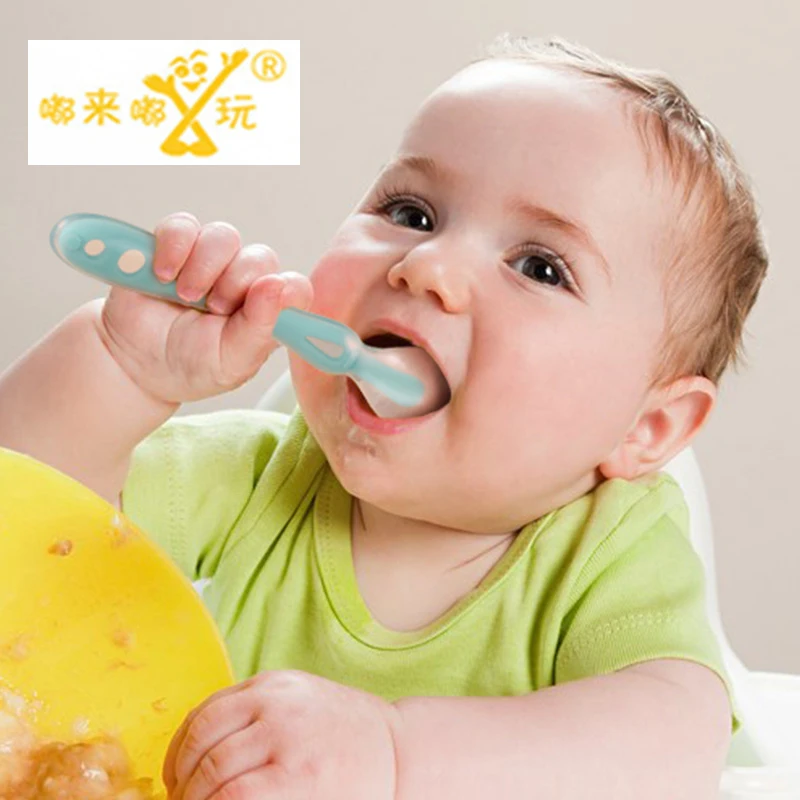
- Maroon spoons are spoons you commonly see therapists use. They’re a bit pricier though. The bowl is relatively narrow and flat, which is perfect for babies to pull puree off of more easily. These spoons are made from harder plastic.
- Flat Spoon Dippers
- These spoons were intended for babies to feed themselves. The bowl is narrow, textured, and completely flat. There is also a guard to prevent your baby from pushing the spoon too far down. Great for reducing gagging.
- EZ PEZE bowl
- While this isn’t a spoon, it’s a great tool to have on hand when you’re feeding your baby purees. It suctions to the tray and doesn’t slip very easily. It can be really helpful, especially if your baby loves to throw their bowl.
You’re all set! It’s time to feed that sweet little baby. Try to have fun. Let your baby play, experiment, and laugh while eating.
Let them get messy! (See why here)
Got any questions? Leave them in the comments below, we respond to every single one.
And, if you want to get ready for the next steps of feeding, table foods, grab our guide for teaching your baby how to learn to chew and eat them here!
More on Feeding Babies
5 Things Parents With They’d Known Sooner About Feeding Their Baby or Toddler
Why Your Baby Should Be Putting Toys in Their Mouth
Feeding Schedule for 8, 9 and 10 Month Olds
Must-Know Pros and Cons of Using Baby Food Pouches
Andrea Timler is a licensed occupational therapist and part of the Your Kid’s Table Team. She has over 7 years experience with expertise in development and feeding in babies, toddlers, and children. Andrea also has 4 kiddos of her own at home.
She has over 7 years experience with expertise in development and feeding in babies, toddlers, and children. Andrea also has 4 kiddos of her own at home.
6 Spoon-Feeding Techniques to Create Lifelong Healthy Eating Habits | by My Baba
Nancy Ripton and Melanie Potock, authors of ‘Baby Self-Feeding’, encourage you to make your own informed decision on whether or not to feed your baby purees. Like finger foods, purees play an important role in mouth development and learning to accept different food tastes and textures. In their view, purees should be a part of your child’s early food experience and beyond, in conjunction with safe finger or handheld foods. Young children can handle different tastes, textures, and feeding experiences. Sampling a variety of foods now leads to a child who is a more adventurous eater later in life.
The Role of Early Spoon-Feeding
Spoon-feeding your baby purees plays a specific, useful role.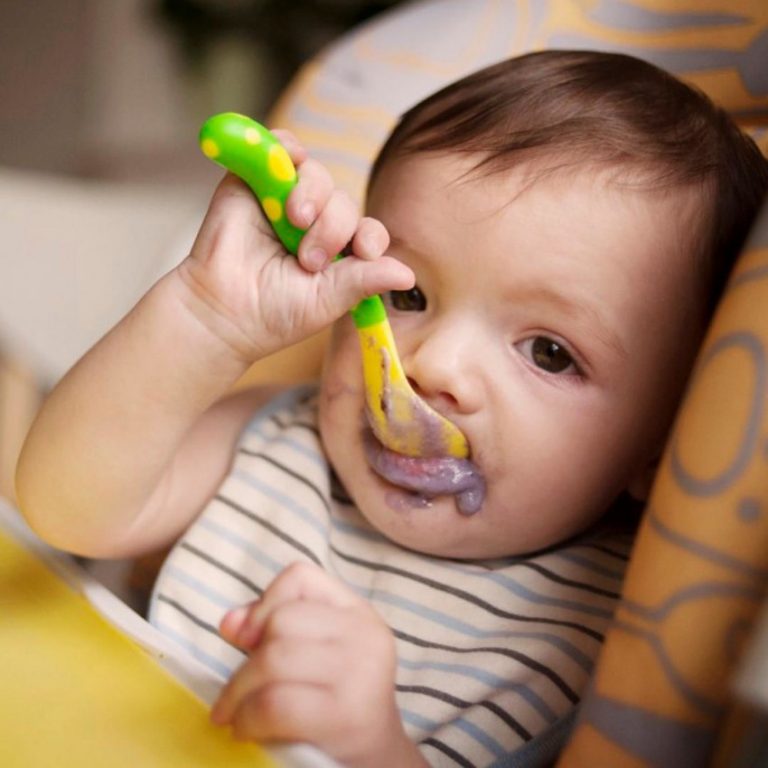 Babies develop better lip control and movement as they suck a puree off a spoon. It also limits the amount of food your baby will spit out and gets more food into your baby’s tummy. However, most parents place the spoon in their child’s mouth and then scrape the food off on the top of their baby’s lip as they remove the spoon. Instead, you can teach your baby to suck the food off the spoon.
Babies develop better lip control and movement as they suck a puree off a spoon. It also limits the amount of food your baby will spit out and gets more food into your baby’s tummy. However, most parents place the spoon in their child’s mouth and then scrape the food off on the top of their baby’s lip as they remove the spoon. Instead, you can teach your baby to suck the food off the spoon.
PROPER SPOON-FEEDING TECHNIQUES
Teaching your baby to suck food off a spoon the correct way helps to position her tongue in the proper place in order to push food toward her throat.
- Get down on eye level with your baby. Do not feed your baby while you are standing above her. When a baby has to look up at you, it makes it more difficult for her to swallow comfortably. Plus, you’ll tend to lift the spoon upward.
- Start with the tip of the spoon dipped in the puree. Think of first tastes as just that — a taste. Gradually work up to a spoonful.
- Bring the spoon toward your baby’s mouth, waiting for him to open and accept the spoon.
 Reading your baby’s cues is essential. You are building a nurturing relationship where the shared experience of feeding is the foundation. Resist the urge to scrape the food off on your baby’s upper lip or the roof of his mouth. Allow him to close his top lip and suck the puree off the spoon while you guide the spoon straight out of his mouth in tandem. Keeping the spoon parallel to the floor helps your baby develop the proper tongue position for the next phase, swallowing.
Reading your baby’s cues is essential. You are building a nurturing relationship where the shared experience of feeding is the foundation. Resist the urge to scrape the food off on your baby’s upper lip or the roof of his mouth. Allow him to close his top lip and suck the puree off the spoon while you guide the spoon straight out of his mouth in tandem. Keeping the spoon parallel to the floor helps your baby develop the proper tongue position for the next phase, swallowing. - Allow time for your baby to propel the puree backward and swallow. This typically takes a second or two, but at first you’ll notice baby pushing the food back out and then swallowing. With time, this suckle reflex (a forward/backward motion) will begin to fade and she will eventually swallow more food than she pushes out.
- Repeat. Remember to read your baby’s cues, smile, and talk to him. Eating is a social experience. You’ll know your baby is eager to participate if he:
- Opens his mouth as the spoon approaches.
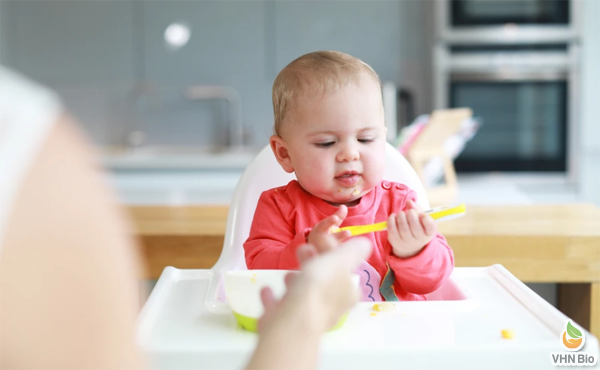
- Leans forward slightly to accept the spoon.
- Has a pleasant expression on his face.
- Gazes at you while you are feeding.
- Grabs at the spoon to bring it to his mouth on his own or with your help.
- If baby closes her mouth, becomes fussy, or is otherwise resistant to eating, don’t force it. Put the food away and feed with breast milk or formula. Then try puree again in another day or two. Watch for signs that your baby is not ready to be fed:
- Turns away from the spoon
- Closes mouth when spoon approaches
- Gags
- Gazes away from the spoon
- Blocks spoon with hands or covers mouth with hands
The Benefits of Starting with Purees
- Reduces gagging and discomfort for baby.
- Increases chance of having a positive first experience with food.
- Helps teach your baby proper swallowing technique.
- Introduces your child to the texture of pureed food
CHOOSING THE RIGHT SPOON
A spoon is simply a tool to present purees. Many parents in countries around the world use their finger, a piece of solid food dipped in puree, or even baby’s own hands as the first tool for presenting “suckable” foods. For the purposes of this book, we suggest a spoon, with the understanding that it’s the act of sucking the puree that is most important.
Many parents in countries around the world use their finger, a piece of solid food dipped in puree, or even baby’s own hands as the first tool for presenting “suckable” foods. For the purposes of this book, we suggest a spoon, with the understanding that it’s the act of sucking the puree that is most important.
Parents often feed babies with adult-size spoons or toddler spoons, when in fact the first spoon should be very flat with a small “spoon-bowl.” Babies have small mouths and need small spoons for comfort and for learning how to suck food off a spoon. Choose a spoon that has a flat, narrow bowl just big enough to fit over your baby’s tongue, but not cover the edges of the tongue. Your child needs to be able to lift the sides (lateral margins) of her tongue upward just slightly as the spoon rests on her tongue, then close her top lip and clean the food off the spoon as you draw it out of her mouth. Learning to use the lateral margins of the tongue and the lips (especially the top lip) helps a child develop a mature swallow pattern for chewing and swallowing more advanced textures with ease.
The Transition to Self-Spoon-Feeding
The secret to getting the most out of self-feeding is to know when to move on from exclusive purees. Most babies can start to self-feed by seven months. Although you can continue to offer purees occasionally, they should no longer make up a large part of your baby’s diet after seven or eight months of age. A baby who gets too used to a certain way of eating can become reluctant to try new tastes and textures. He will also miss out on the learning experience of feeding himself at a young age. Once your baby can competently swallow purees, it’s time to introduce self-spoon-feeding and finger foods. Babies will begin dipping with a spoon around nine months of age. The next step is scooping, which may emerge a few months later. Parents can keep offering spoonfuls of purees and mashed foods to their babies until about 12 months of age. Offering a spoon occasionally during this time period exposes children to a variety of tastes and textures while they learn to manage the dipping, and later scooping, stages on their own.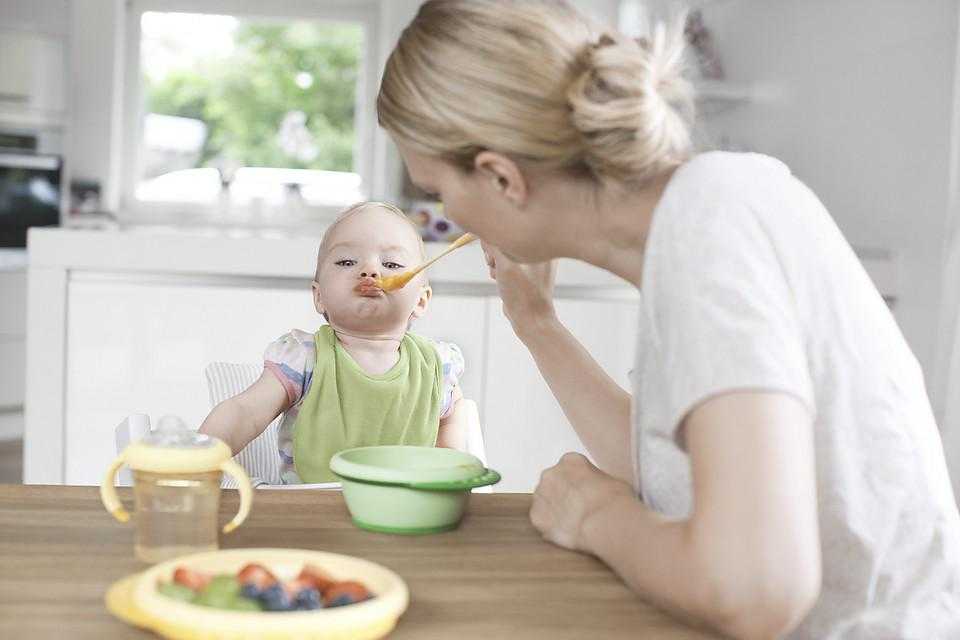 Mastering messy, self-spoon-feeding may not happen until about 15 to 18 months.
Mastering messy, self-spoon-feeding may not happen until about 15 to 18 months.
Edited extract from Baby Self-Feeding: Solid Food Solutions to Create Lifelong, Healthy Eating Habits by Melanie Potock and Nancy Ripton, published by Fair Winds Press (£16.99), is out now.
How to spoon feed? - Encyclopedia Baby food
Levchuk Victoria © Levchuk Victoria ©An article for those who supplement with a spoon or how to feed with a spoon. We will not discuss whether it is useful to supplement / spoon feed a child, about the benefits of independence, etc. Let's talk about the right and wrong way to spoon feed. The wrong way is to raise your hand up when you take the spoon out of the child's mouth. This method cleans the spoon from food on the teeth, gums or upper lip.
Scraping is not a normal, natural way of feeding. This method of feeding prevents the lips from doing their job and shrinking around the spoon.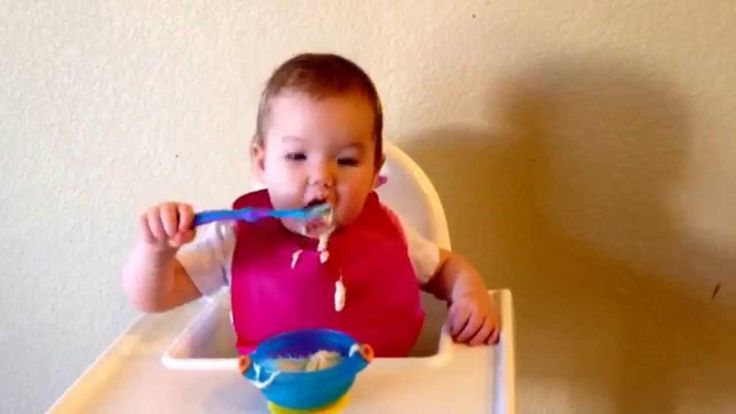 In this case, the child's head leans back when he tries to lick the spoon and swallow food.
In this case, the child's head leans back when he tries to lick the spoon and swallow food.
Most often we see well-intentioned parents putting a spoon in their child's mouth. The adult lifts the spoon and cleans the spoon most often on the baby's upper lip . This can be an effective way of getting food into the child's mouth, but the child does not practice using the muscles of the lips, cheeks, and jaw in a more controlled and mature manner.
Table of contents:
Have him see and smell the food before putting it in his mouth. Let your child touch the food with their fingers before putting it in their mouth. He might want to dip his finger into the plate and lick it, okay. The first time feeding is necessary, the baby is exploring the world in this way.
2. Put the spoon on the tongue and hold it there until the child closes the lips.
3. Then take the spoon straight out of the mouth (not at an angle). The chin should remain straight and not rise up. The child must learn to eat food, and thoughtless swallowing does not teach anything. If the mother undertook to feed the child from a spoon, then we do it right.
The chin should remain straight and not rise up. The child must learn to eat food, and thoughtless swallowing does not teach anything. If the mother undertook to feed the child from a spoon, then we do it right.
4. Rejection . If he refuses, then offer the child several times, you can just get your lips dirty in food so that he licks them in order to feel the texture and taste of food on his lips in a playful way. Let's not rush.
Related articles:
- How to teach a child to chew?
- At what age does a child begin to eat independently?
Spoon-feeding and speech
What is spoon-feeding? Just opened, chewed, closed. But it turns out that the sensory-motor system is involved in the process of spoon-feeding. Here are a few examples of the benefits of proper spoon feeding.
1. When the spoon is fed into the mouth in a forward/forward motion, the child must use the lip muscles to clear the spoon of food. These are the same muscles that are used to create the sounds "M", "P", "B".
These are the same muscles that are used to create the sounds "M", "P", "B".
2. The suggestion of a spoon straight will make it easier to round the lips. Rounding the lips helps to make the sounds "O", "U", "A".
3. Offering a spoon from the side or corner of the lips will make it easier to close the lips. Closing the lips helps to make the sounds "M", "P", "B".
4. Closing the lips is also important for controlling saliva and keeping food in the mouth while eating.
5. Over time, the spoon helps the child practice using the jaw muscles as they open and close their mouth to eat in a more controlled way.
How can I help my child eat from a spoon?
Children should instinctively close their lips, but if they don't, there are a few things that can be done to help oral-motor skill:
until the lips close.
2. You can press lightly on the tongue to close the lips.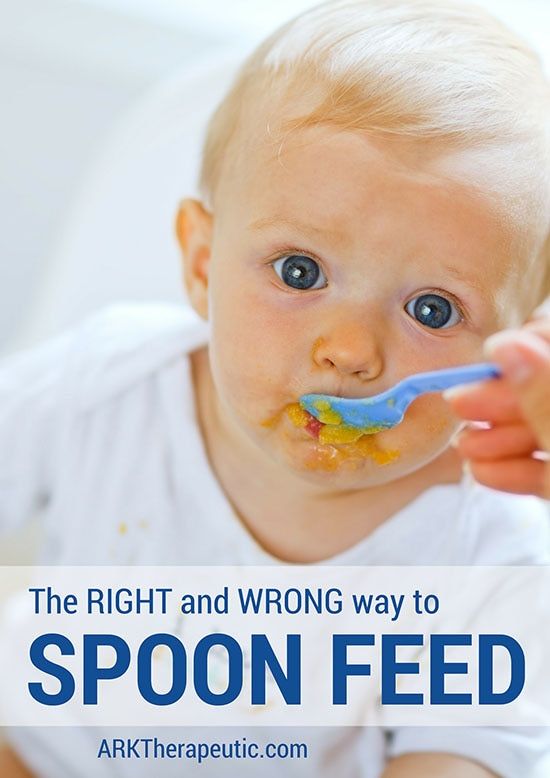
3. For children with oral-motor problems, 9 can be selected0011 vibrating spoon , and also massage the gums before eating.
4. It may be necessary to stretch the lips beforehand to help close the lips.
Gymnastics to learn to close the mouth
There are many different lip stretching techniques that parents can try to spoon feed their baby:
- Gently pull out the upper lip with the pad of your finger. Repeat on the lower lip, gently stretching it up.
- Gently pinch the philtrum or philtrum (the skin between the nose and upper lip) and pull downwards. Repeat the procedure on the skin just below the middle of the lower lip, gently stretching.
- Connect index finger and thumb together. Place them directly under the nose and then point your fingers apart along the lip line. Repeat the same movement just under the lower lip.
- Stand behind the child and place the index finger over the upper lip , and the middle finger under the lower lip.
 Close your fingers like scissors to close your lips.
Close your fingers like scissors to close your lips.
This exercise can be done before meals or during. Stretching the lips before eating may not be enough, so once the child loses closure, it can be repeated again.
Also, do not load the spoon with too much food. Small portions of food are the best for baby's first feeding experiences. Too much food is difficult to take from a spoon and chew.
Usually, when parents misfeed a child with a spoon, it's either because they don't know about the correct way or they are in a hurry. So now that you have read the article about the right and wrong way, then do not rush the baby during the meal. Eating will take longer, but there will be less wasted food, less salivation, and much more benefit from oral motor skills allowing the lips to exercise.
We are not afraid and add me to VK and Odnoklassniki, Instagram!
Like the article? Subscribe to site updates
"Encyclopedia Baby Food"!
Don't forget to bookmark us! (CTRL+SHIFT+D) Subscribe to the site, comment, share in social networks.
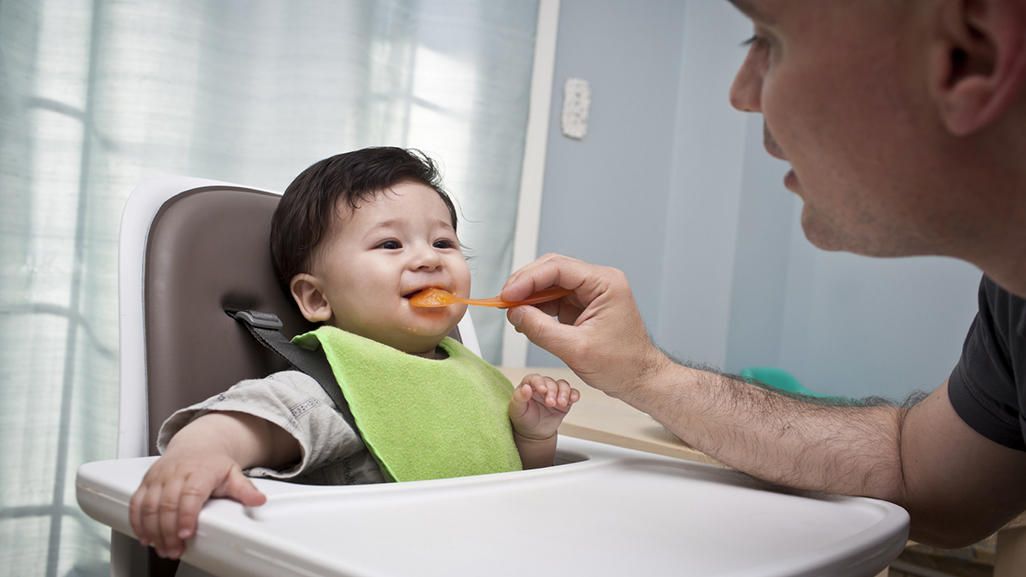
On our website Encyclopedia Baby Food there is useful information on the nutrition of your children, which is useful for everyone, and we update the website "Encyclopedia Baby Food" constantly and try to search and write only excellent, verified and necessary information for you and your children.
Disclaimer No. 1: It must be understood that the author of the articles on the Baby Food Encyclopedia website is not a medical staff, “I am not a doctor.” The information I share is based on my own experience. My goal is not to teach you how to eat or feed your child, but to talk about how we did it, what new things I learned or read. This expands the picture of Baby Food knowledge, gives you a glimpse of the whole process so you can decide if you like it or not.
Disclaimer No. 2 : However, the above does not cancel visiting a pediatrician. Before you start complementary foods, you need to get his professional opinion on the best way to introduce new foods for your baby.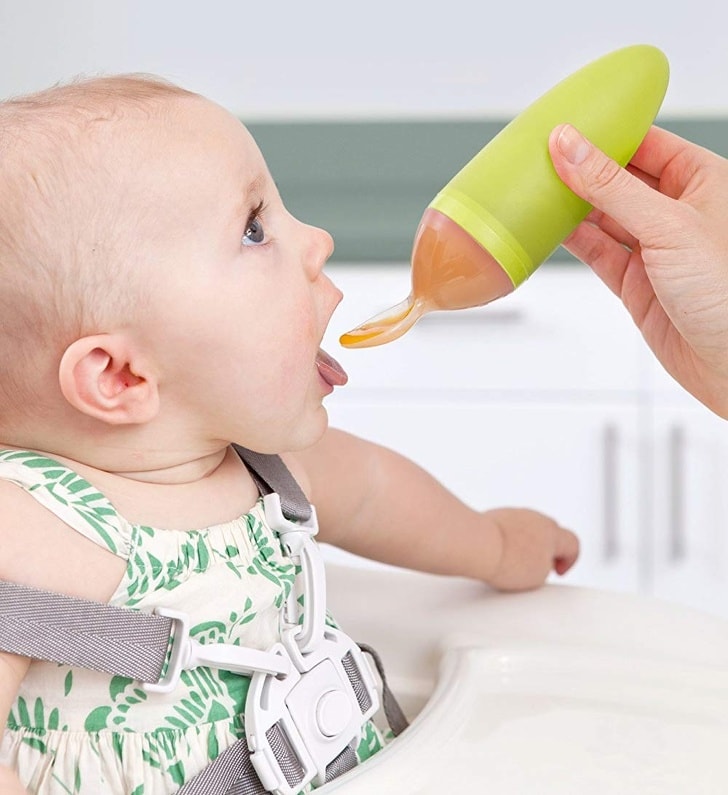 I also draw your attention to the fact that you need to look at the original date of the published articles, because some of the "best practices" may have changed. Always check with your child's pediatrician about complementary foods and their health.
I also draw your attention to the fact that you need to look at the original date of the published articles, because some of the "best practices" may have changed. Always check with your child's pediatrician about complementary foods and their health.
Disclaimer #3: Keep in mind that every family is unique, every situation is also completely unique. There are no universal solutions. Only you can find what works best for you. Certain goals require certain sacrifices and priorities - not everyone wants to make those choices, and that's GREAT! Just know what you want to achieve, and be ready to get to work, putting the best of your strength!
Disclaimer No. 4: On the Encyclopedia Baby Food website, photos from books on baby food with attribution are used to better understand the information (Article 1274, paragraph 1, part four of the Civil Code of the Russian Federation). Literature on baby food is found in the public domain on the Internet.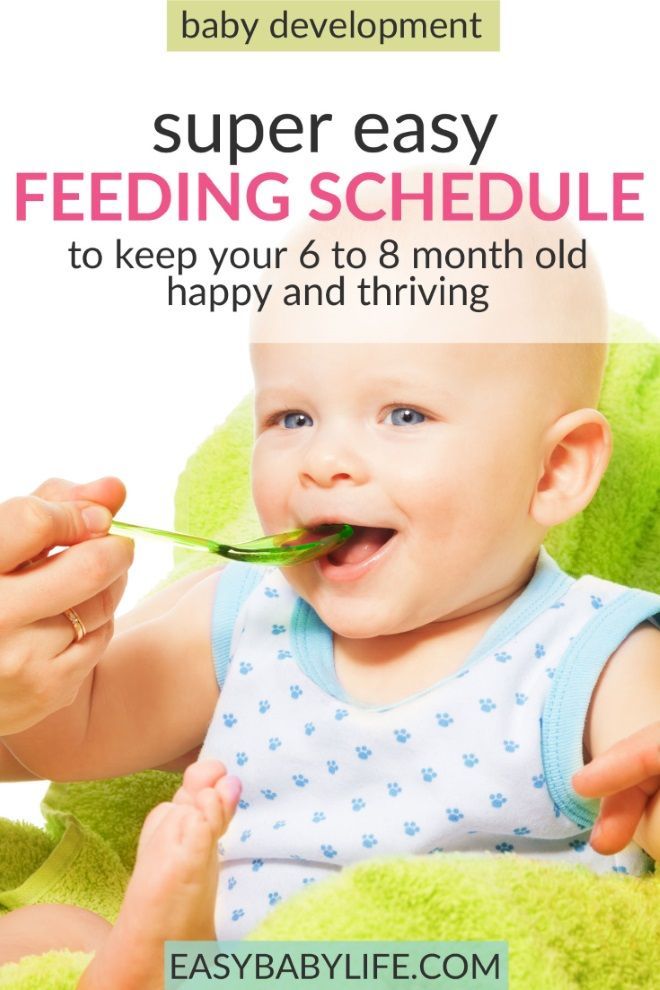
Apricot puree with chicken
Banan-global puree
Banana puree
borsch
Bousse broth with peas and rice
Boturbrod with kolrabi
Quick dessert
Sine Buckwheat porridge with apricots
Buckwheat porridge with banana
Buckwheat pilaf
Children's sausage
Children's milk porridge with banana
Children's vinaigrette
Children's ketchup
Children's cucumber salad
Children's Olivier salad
Children's porridge biscuits
Children's puree of strawberries, bananas, yellow cherries, yoghurt and biscuits with cereals
Children's puree with cottage cheese and fruits
Homemade yeast bread with linseed flour
Homemade cheese
Homemade pizza
Breakfast outside
Kohlrabi appetizer
Cauliflower roast
Roasted carrots
Roasted carrots and cherries with millet
Winter salad with Jerusalem artichoke
Cabbage with white beans
Canteen-style coleslaw
Mashed potatoes
Quinoa and pumpkin porridge
Quinoa porridge
breakfast cereals
Quinoa and apple
Strawberry puree
Strawberry puree with banana
Strawberry compote
Dried apple and raspberry compote
in a thermos" for a child older than 8 months
Corn porridge
Corn porridge with pear
Corn porridge with pumpkin
Corn porridge with pumpkin and carrots
Corn porridge with apple and carrots
Chicken liver in the oven
Chicken cutlets with carrots
Chicken with carrots, sweet peppers and potatoes
Navy pasta
Pasta with orange sauce
Pasta with Gremolata
Muffins with vegetables and egg
Young potatoes in their skins 19 Vermicelli soup
Carrot-potato puree
Carrot-rice casserole
Carrot with chicken
Amanita from eggs and tomatoes
Meat envelopes
Homemade Tarragon drink for children
Vegetable puree from cauliflower and carrots
Vegetable soup with corn semolina
Vegetable soup with cheese and corn semolina
Vegetable soup with spinach
Vegetable puree soup with bell pepper
Oatmeal porridge
Pollock fritters
Hot kefir fritters
Cauliflower omelet 90 in a bag
Spinach and Cheese Omelet
Omelette Pancake
Peach Puree
Baked Apples 7 months +
Zucchini and Carrot Pie
Zucchini Pie
Rice and Zucchini Pie
Fish Pie
Fish and potato pie
White cabbage pizza
Lavash pizza
Zucchini, tomato and sausage pizza
Tomato and olive pizza
Spinach pizza
Rabbit pilaf
Chicken pilaf with green peas and corn Puree
and cherries
Banana, cottage cheese and porridge puree 4 cereals
Broccoli (cauliflower) puree
Broccoli, courgette and cauliflower puree
Blueberry puree
Pear puree
Pear and banana puree
Pear and banana puree, baked
Pear and pumpkin puree 7 months +
Pear, pumpkin and peach puree
Pear, apple, plum and prunes puree
Blackberry puree
Turkey puree
Zucchini puree 90 zucchini and broccoli
Zucchini, carrot and potato puree
Quinoa and banana puree
Quinoa and carrot puree
Quinoa, banana and carrot puree
Quinoa, squash and carrot puree
Quinoa, peach and raspberry puree
quinoa, cauliflower, apple, peas and mint
Quinoa, apple, pear and raisin puree
Quinoa, apple, carrot puree
Rabbit, broccoli and cauliflower puree
Chicken, carrot, potato, apple and pea puree
Raspberry, cherry and banana puree
carrots
Carrot and apple puree
Carrot, potato, broccoli puree with cheese
Carrot, potato, apple and quinoa puree
Carrot, pumpkin, apple and prunes puree
Carrot, apple and potato puree
Turnip and carrots
Plum puree
Cottage cheese, strawberry and banana puree
Pumpkin puree
Pumpkin and banana puree
Pumpkin and squash puree
Pumpkin and apple puree
Pumpkin, apple and banana puree
Cauliflower and broccoli puree1599 Cauliflower & Potato Puree
Cauliflower & Rice Puree
Cauliflower & Apple Puree
Cauliflower, Green Pea & Squash Puree
Cauliflower, Turkey & Potato Puree
Cauliflower, Potato & Squash Puree
Cauliflower, carrot and broccoli puree
Cauliflower, carrot, cheese and rice puree
Cauliflower, apple and courgette puree
Zucchini puree
Zucchini and potato puree
Zucchini, carrot and apple puree 90 cherries
Blueberry puree
Prune puree
Apple, pumpkin, carrot and some curry puree
Apple and pear puree
Apple and strawberry puree
Apple, strawberry and cherry puree
Apple, peach and banana puree
Carrot and pumpkin puree
Cottage cheese and banana puree
Turkey, potato and carrot stew
Zucchini, carrot and broccoli stew
Fish, potato, carrot and broccoli stew
Rice porridge
Whole grain rice porridge
carrot
Rice porridge with pumpkin
Rice porridge with apples
Rice porridge with apple and pear
Rice porridge with apple and pumpkin
Fish cakes with vegetables
Semi-cooked fish
Fish meatballs with ketchup
Baby Fish Soup
Salmon and Celery Fish Soup
Carrot and Kohlrabi Salad
Chickpea Salad
Chickpea and Cabbage Salad
Laziest Soup
Creamy Kohlrabi Soup
Oatmeal Smoothie in Pot
Cheese Pizza
Pea and Bacon Soup
Baked Vegetable Soup
Kohlrabi Soup
Salmon Soup
Cauliflower Soup
Turnip Potato Soup
Meatball Soup for the Picky Eater
Green apple kohlrabi soup
Rabbit, pumpkin, potato, broccoli and cauliflower soup
Beetroot soup
Pumpkin mushroom soup
Broccoli and celery soup
Soup/stew Pork with Potatoes and Carrots
Cheese Pasties
Pumpkin Cheese Sauce (Annabelle Carmel Recipe)
Buzz Lightyear Sandwich
Pumpkin Apple Puree
Pumpkin Apple Juice
Pumpkin Cake
Pumpkin Soup Puree
5 Fruit Salad
Cauliflower with cheese
Linden tea and thyme
Experimental vermicelli and lentil soup
Apple puree
Apple juice
Like this article? Subscribe to site updates
"Encyclopedia Baby Food"!
Don't forget to bookmark us! (CTRL+SHIFT+D) Subscribe to the site, comment, share in social networks.

On our website Encyclopedia Baby Food there is useful information on the nutrition of your children, which is useful for everyone, and we update the website "Encyclopedia Baby Food" constantly and try to search and write only excellent, verified and necessary information for you and your children.
Disclaimer No. 1: It must be understood that the author of the articles on the Baby Food Encyclopedia website is not a medical staff, “I am not a doctor.” The information I share is based on my own experience. My goal is not to teach you how to eat or feed your child, but to talk about how we did it, what new things I learned or read. This expands the picture of Baby Food knowledge, gives you a glimpse of the whole process so you can decide if you like it or not.
Disclaimer No. 2 : However, the above does not cancel visiting a pediatrician. Before you start complementary foods, you need to get his professional opinion on the best way to introduce new foods for your baby. I also draw your attention to the fact that you need to look at the original date of the published articles, because some of the "best practices" may have changed. Always check with your child's pediatrician about complementary foods and their health.
I also draw your attention to the fact that you need to look at the original date of the published articles, because some of the "best practices" may have changed. Always check with your child's pediatrician about complementary foods and their health.
Disclaimer #3: Keep in mind that every family is unique, every situation is also completely unique. There are no universal solutions. Only you can find what works best for you. Certain goals require certain sacrifices and priorities - not everyone wants to make that choice, and that's GREAT! Just know what you want to achieve, and be ready to get to work, putting the best of your strength!
Disclaimer No. 4: On the Encyclopedia Baby Food website, photos from books on baby food with attribution are used to better understand the information (Article 1274, paragraph 1, part four of the Civil Code of the Russian Federation). Literature on baby food is found in the public domain on the Internet.
Disclaimer No. 5: Content, editing, proofreading, layout, etc. produced ONLY by the author of the site Encyclopedia Baby food. Therefore, I apologize for spelling, punctuation and stylistic errors. If you notice a mistake, please report it, and do not write angry comments about the illiteracy of the author of the article.
Apricot puree with chicken
Banana-apple puree
Banana puree
Borscht
Broth with peas and rice
Baby mashed potatoes with cottage cheese and fruits
Home yeast bread with linen flour
Home cheese
Home pizza
Breakfast on the street
Opeling from kolrabi
Causage carrots
Baked carrots and cherries with a prose of 9015 white beans
Cabbage salad
Mashed potatoes
Quinoa and pumpkin porridge
Quinoa porridge
Breakfast cereals
Quinoa and apple
Strawberry puree
Strawberry puree with banana
Strawberry compote
Compote of wild apples and raspberries
Compote of dried fruits steamed in a thermos for a child over 8 months
Corn porridge
Corn porridge with pear
Corn porridge9 with pumpkin
Corn porridge with pumpkin and carrot159 Corn porridge with apple and carrots
Chicken liver in the oven
Chicken cutlets with carrots
Chicken with carrots, sweet peppers and potatoes
Navy pasta
Pasta with orange sauce
Pasta with Gremolata
Muffins with vegetables and egg
New potatoes in their skins
Vermicelli milk soup
Carrot and potato puree
Carrot and rice casserole
Carrot with chicken
Fly agaric from eggs and tomatoes children
Cauliflower and carrot vegetable puree
Vegetable soup with corn semolina
Vegetable soup with cheese and corn semolina
Vegetable soup with spinach
Vegetable soup-puree with bell pepper
Oatmeal porridge
pancakes from polions
pancakes on hot kefir
omelet in the package
omelet with broccoli and cauliflower
omnete with spinach and cheese
omnet pyra
Rice and zucchini pie
Fish pie
Fish and potato pie
White cabbage pizza
Lavash pizza
Zucchini, tomato and sausage pizza
Tomato and olive pizza
Pizza with spinach
Rabbit pilaf
Chicken pilaf with green peas and corn
Banana and cherry puree
Banana, cottage cheese and porridge puree 4 grains
Broccoli (cauliflower) puree
Broccoli, squash and cauliflower puree
Blueberry puree
Pear puree
Pear and banana puree
Pear and banana puree, baked
Pear and pumpkin puree 7 months +
Pear, pumpkin and peach puree
Pear, apple, plum and prunes puree
Blackberry puree
Turkey puree
Zucchini puree
Zucchini and broccoli puree
Zucchini, carrot and potato puree
Quinoa and banana puree
Quinoa and carrot puree
Quinoa, banana and carrot puree 9015
Quinoa, peach and raspberry puree
Quinoa, cauliflower, apple, pea and mint puree
Quinoa, apple, pear and raisin puree
Quinoa, apple, carrot puree
Rabbit, broccoli and mint puree cauliflower
Chicken, carrot, potato, apple and pea puree
Raspberry, cherry and banana puree
Carrot puree
Carrot and apple puree
Carrot, potato, broccoli puree with cheese
Carrot, potato, apple and quinoa puree
Carrot, pumpkin, apple and prunes puree
Carrot, apple and potato puree
Turnip and carrot puree
Plum puree
Cottage cheese, strawberry and banana puree
Pumpkin puree
Pumpkin and banana puree
Pumpkin and banana puree
and zucchini
Pumpkin and apple puree
Pumpkin, apple and banana puree
Cauliflower and broccoli puree
Cauliflower and potato puree
Cauliflower and rice puree
Cauliflower and apple puree
Cauliflower and green pea puree and squash
Cauliflower, turkey and potato puree
Cauliflower, potato and squash puree
Cauliflower, carrot and broccoli puree
Cauliflower, carrot, cheese and rice puree
Cauliflower, apple and squash puree
Zucchini puree
Zucchini and potato puree
Zucchini, carrot and apple puree
Cherry puree
Blueberry puree
Prune puree
Apple, pumpkin, carrot and some curry puree
toy5 apple puree apple and strawberry puree
Apple, strawberry and cherry puree
Apple, peach and banana puree
Carrot and pumpkin puree
Cottage cheese and banana puree
Turkey, potato and carrot stew
Zucchini, carrot and broccoli stew
Fish, potato, carrot and broccoli stew
Rice porridge
Whole grain rice porridge
Rice porridge with carrots
Rice porridge with pumpkin
Rice porridge with apples
Rice porridge with apple and pear
Rice porridge with apple and pumpkin
Rice porridge with apple and pumpkin
cutlets with vegetables
Ready-to-cook fish
Fish meatballs with ketchup
Fish soup for children
Fish soup with salmon and celery
Carrot and kohlrabi salad
Chickpea salad
Chickpea and cabbage salad
Laziest Soup
Creamy Kohlrabi Soup
Oatmeal Smoothie
Pot Sauce
Cheesy Pizza Sauce
Pea and Bacon Soup
Roasted Vegetable Soup
Kohlrabi Soup 9019 Salmon Soup
Cauliflower Soup
with potatoes and turnips
Meatball soup for the picky eater
Kohlrabi puree soup with green apple
Rabbit, pumpkin, potato, broccoli and cauliflower soup
Beetroot puree
Pumpkin puree with mushrooms
Broccoli and Celery Soup
Pork Potato and Carrot Soup/Stew
Cheese Chebureks
Pumpkin Cheese Sauce (Annabelle Carmel Recipe)
Buzz Lightyear Sandwich
Pumpkin-Apple Puree
Pumpkin-Apple Juice
Pumpkin Juice
Pumpkin-Apple Juice
puree soup
Fruit salad
Mango fruit salad
Lavash bread
Cauliflower with cheese
Linden tea and thyme
Experimental vermicelli and lentil soup puree
Apple puree
Apple juice
Proper and incorrect methods of feeding from a spoon
Proper and incorrect methods of feeding from a spoon
Translator: Marina Llyukhina
Editor: Marina Lelyukhina: Llyukhina
Original: https: //wwww.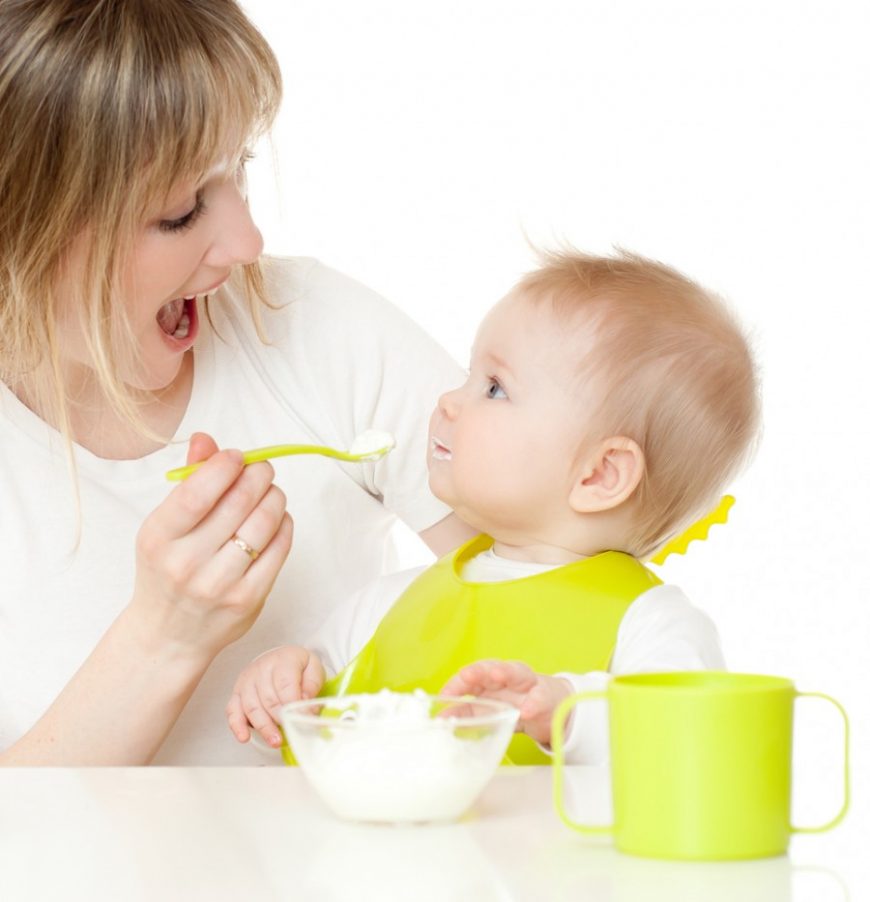 rktherapet. com/blog/the-right-and-wrong-way-to-spoon-feed/
rktherapet. com/blog/the-right-and-wrong-way-to-spoon-feed/
Our Facebook group: https://www.facebook.com/specialtranslations
Our Vkontakte public: https:/ /vk.com/public57544087
If you liked the material - help those who need help: http://specialtranslations.ru/need-help/
Copying the full text for distribution in social networks and forums is possible only by quoting publications from the official pages of Special Translations or through link to the site. When quoting text on other sites, put the full translation heading at the beginning of the text
Did you know that spoon-feeding can be wrong? The wrong way is to raise your hand up as if you want to remove the spoon from the child's mouth. Thus, before the food is in his mouth, the spoon will scratch his teeth, tongue and upper lip.
Scraping food off a spoon while eating is not correct. This method is especially unsuitable for children with a delay in oral-motor development.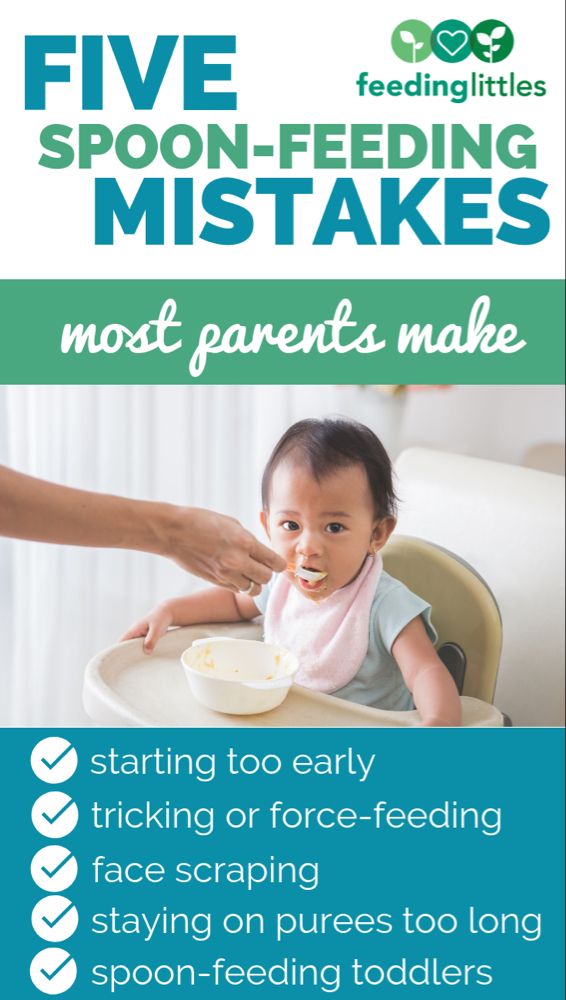 This makes it impossible for the lips to do their job of closing around the spoon. It also causes the baby to reach for the spoon, as can be seen in the picture above or below at the start of the video.
This makes it impossible for the lips to do their job of closing around the spoon. It also causes the baby to reach for the spoon, as can be seen in the picture above or below at the start of the video.
How to spoonfeed correctly: Place the spoon on the top of the tongue and hold until the baby closes its lips. Then take the spoon straight out of your mouth (don't hold it at an angle). The child should sit straight, not lift his head. As the girl's mother rightly noted in the video, thanks to this position she eats, not you feed her. On the last spoon in the video, you can see how her lips work.
Children should instinctively close their lips, but if they fail, there are several ways to help build oral motor skills:
- Give it time - you can hold the spoon until the child closes their lips.
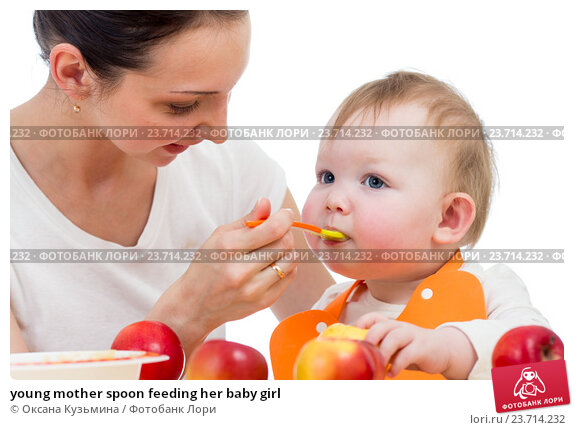
- You can also gently press the spoon on your tongue to stimulate your lips.
- For children with strong sensory protection in the mouth, a vibrating spoon can help wake up the mouth and reduce sensitivity. Tongue massage before meals (and throughout the day) can also help
- You can preliminarily stretch your lips slightly to help them grasp the spoon.
There are several techniques to stretch the lips:
- Gently pull the upper lip down with the tip of your finger (or your whole finger). Repeat the same on the lower lip - gently pull it up. The same can be done with the Y-Chew probe
- Gently grab a piece of skin between the nose and upper lip and pull it down. Repeat with the area of skin just under the lower lip - pull it up.
- Bring your thumb and forefinger together and place them between your nose and upper lip, spread your fingers, pressing them against your lip. Repeat with lower lip
- Stand behind the child and place the index finger on the upper lip and the thumb under the lower lip, close the fingers like scissors to help the child close the lips
Your therapist will help you learn how to put these techniques into practice.